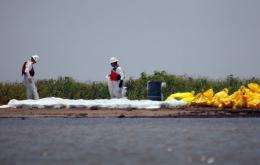Workers clean a beach after tar balls washed up in South Pass, Louisiana in 2010. A key US government report spreads the blame for the massive oil spill in the Gulf of Mexico, citing a bad cement job and poor management decisions by BP and its subcontractors.
A key US government report spreads the blame for the massive oil spill in the Gulf of Mexico Wednesday, citing a bad cement job and poor management decisions by BP and its subcontractors.
The finding by the agency that regulates offshore drilling could strengthen BP's legal case for recovering some of the massive costs of the spill from Halliburton, which performed the cement job, rig owner Transocean and parts manufacturer Cameron, which supplied the faulty blowout preventer.
The report concluded that a "central cause of the blowout was failure of a cement barrier."
The loss of 11 lives aboard the rig and the subsequent pollution were "the result of poor risk management, last-minute changes to plans, failure to observe and respond to critical indicators, inadequate well control response, and insufficient emergency bridge response training," the report concluded.
BP has spent $40.7 billion on the biggest maritime oil spill in history and could still be liable for billions in fines, compensation and restoration costs.
It is currently embroiled in a series of lawsuits over apportioning the costs and said in a statement that it agrees with the report's "core conclusion" that the accident was "the result of multiple causes, involving multiple parties, including Transocean and Halliburton."
A presidential commission tasked with investigating the spill also blamed the disaster on management failures by BP, Halliburton and Transocean.
"From the outset, BP acknowledged its role in the accident and has taken concrete steps to further enhance safety and risk management throughout its global operations," the BP statement said.
"We continue to encourage other parties to acknowledge their roles in the accident and make changes to help prevent similar accidents in the future."
Transocean and Halliburton did not immediately return a request for comment.
Wednesday's report comes at the conclusion of a 17-month investigation by the US Coast Guard and the Bureau of Ocean Energy Management, Regulation and Enforcement.
The Coast Guard slammed drilling rig operator Transocean's "poor safety culture" in its initial analysis which was released in April.
It cited poor maintenance, inadequate training and the bypassing of alarms and automatic shutdown systems, which prevented the crew from shutting down the runaway well after it blew and led to a chaotic abandonment of the blazing Deepwater Horizon rig.
While the bureau's report cited numerous failures by Halliburton and Transocean it noted that BP was "ultimately responsible" for operations and concluded that "BP's failure to have full supervision and accountability over the activities associated with the Deepwater Horizon was a contributing cause of the Macondo blowout."
The BP-leased Deepwater Horizon exploded on April 20, 2010.
By the time the well was capped 87 days later, 4.9 million barrels (206 million gallons) of oil had gushed out of the runaway well 5,000 feet (1,500 meters) below the surface of the Gulf of Mexico.
Hundreds of miles of fragile coastal wetlands and beaches were contaminated, a third of the Gulf's rich US waters were closed to fishing, and the economic costs have reached into the tens of billions.
(c) 2011 AFP
























